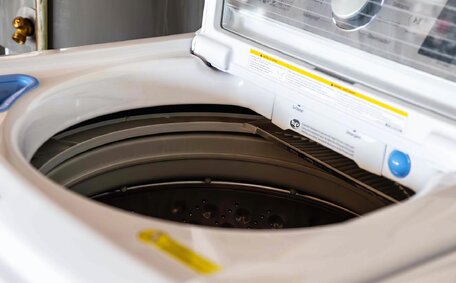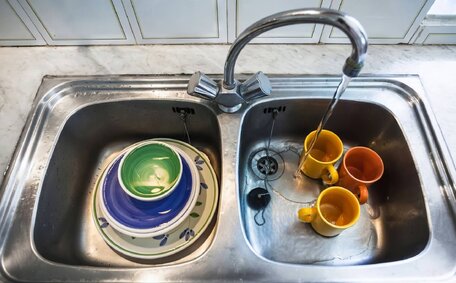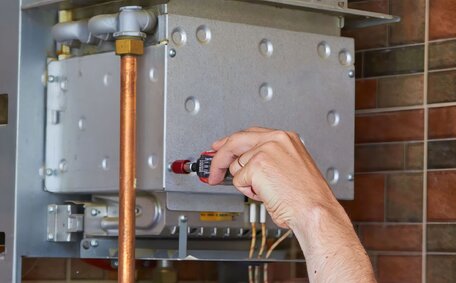Welcome homeowners!
Having the right plumbing tool on hand for your plumbing needs can make a world of difference. When a pipe bursts, toilet clogs, or any other common issue pops up, you’ll be glad you invested in some essential DIY plumbing tools. With the proper gear, many minor problems can be temporarily managed until professional help arrives - saving you money and frustration. We’ll be covering the tools every household should have in their toolbox to take control when plumbing calamity strikes.
Common Household Plumbing Issues
Homeowners inevitably face various plumbing headaches. Getting familiar with some of the most common issues can help you be prepared when problems arise:
- Clogged drains: Hair, soap residue, and food scraps frequently cause blockages in sinks, tubs, and toilets. Using a plunger or drain snake by hand can often dislodge clogs and get things flowing again.
- Leaky faucets: Over time, washers and O-rings get worn out, leading to annoying drips. Replacing these parts with basic tools like an adjustable wrench and Teflon tape usually does the trick.
- Running toilets: If your toilet keeps running constantly, a worn out flapper valve is likely the culprit. Swapping in a replacement flapper restores functionality.
- No hot water: Issues with water heaters like broken heating elements or sediment buildup can disrupt hot water supply. Leveraging a multimeter to test parts can identify problems.
We’ll cover tools and DIY tips to temporarily manage issues like these until a professional plumber can provide service. Advanced problems still require expert help, but basic tools empower homeowners to take charge of minor plumbing matters promptly.
Clogged Drains
Clogged drains are one of the most common plumbing headaches faced by Parramatta homeowners. Buildups of hair, grease, and other gunk frequently get your kitchen sinks, shower drains, and toilet pipes blocked. Using the right tools to clear clogs quickly prevents backing up and flooding that can cause water damage.
The humble plunger is the first line of defence to cut through drain blockages. Investing in quality sink and toilet plungers suited to a variety of fixtures with various nuts and bolts is wise. Repeated forceful plunging can displace clogs to restore flow. Repeated forceful plunging can displace clogs to restore flow. However, caution is needed as these products can damage pipes in other plumbing systems.
For deeper blockages, a hand auger, also known as a drain snake, feeds a long bendable metal cable down the pipe to hook and extract stubborn clogs.
Keep your minor clogged drains dealt with promptly with basic tools to help avoid backing up and ensure things flow smoothly until plumbers can permanently solve trickier issues. Avoiding extensive water damage and avoid costly repairs makes a small DIY investment in key plumbing tools worthwhile for every Parramatta home.
Leaky Pipes
Leaky pipes can cause extensive water damage if not addressed promptly. Having the right DIY plumbing tools on hand empowers homeowners to temporarily stop leaks until professional repairs can be completed.
One essential tool is an adjustable wrench to tighten or loosen leaking joints and other hardware connections. Turning nuts and other hardware can halt drips from threaded pipes. Applying Teflon tape around pipe threads also prevents leaks by sealing connections.
When loosening or tightening a leak, make sure to shut off main water supply first. Attempting a DIY fix is not advisable for large leaks or pipes located in hard-to-reach places.
Protect areas around the pipe to avoid slip hazards. Protect areas around the pipe to avoid slip hazards.
Equipped with the right gear, small accessible leaks can be controlled as a temporary workaround. However, persistent drips or a burst pipe require professional assistance to inspect and rectify underlying issues.
Essential Plumbing Tools
Having the right DIY plumbing tools ready for emergencies can make all the difference. Here are some plumbing tools every homeowner should have in their toolbox:
- An adjustable wrench to grip and turn stuck nuts and bolts when making minor pipe repairs.
- A basin wrench for accessing plumbing fixtures in tight spaces like under sinks.
- Pipe wrenches to secure round pipes for repairs or installing new connections.
- A tubing cutter for cleanly slicing copper pipes to length for projects.
- Teflon tape to wrap threaded pipe connections to prevent leaks.
- A hacksaw suitable for cutting through metal, plastic, or plastic piping to size.
- A caulking gun and waterproof caulk can fill any gaps around pipes to stop drips.
Having these essential tools on hand readies homeowners for plumbing emergencies, allowing them to address many minor mishaps themselves until plumbers can provide service - saving money and preventing extensive water damage in the process.
Plungers
Having the right type of plunger on hand is essential for clearing clogged drains and toilets. There are two main types of plungers homeowners should have:
- A flange (or cup) plunger features a dome-shaped rubber cup attached to a wooden handle. It forms a seal over your sink, tub, and shower drains to plunge away clogs.
- A toilet plunger has a large flat rubber cup with an extended narrow tail fitted over a metal handle. The tail reaches deep into toilet pipes to dislodge obstructions.
Investing in a quality sink plunger and cup plunger models suited to different fixtures saves time and hassle when drain blockages occur. Repeated forceful plunging can displace most clogs to get things flowing again. Having the right plunger for the job avoids damage to fixtures while clearing issues promptly.
While a more generalised flange plunger can work on toilets in a pinch, a specialised toilet plunger is shaped specifically to reach fully down into toilets and provide a tight seal for targeted plunging. This makes it considerably more effective at clearing toilet clogs quickly.
No toolbox is complete without these essential instruments for clearing minor blockages and buying time until plumbers can tackle more complex drain challenges.
Wrenches
Wrenches are essential items for any homeowner’s DIY plumbing toolbox. An adjustable wrench with both 6-inch and 10-inch size options allows grip and leverage to loosen or tighten nuts, bolts, and valves on various plumbing fixtures and pipes. The adjustable, ridged jaws secure fittings of different shapes and sizes.
A pipe wrench is also useful for plumbing tasks. Pipe wrenches clamp round pipes themselves - great for tight spaces where getting a grip is tricky. The adjustable arm and serrated teeth bite securely to turn pipes without slipping.
Using wrenches properly avoids pipe and fitting damage. Always grip tightly and turn smoothly without jerking motions. Using wrenches properly avoids pipe and fitting damage.
Investing in quality like Crescent or Ridgid ensures longevity through years of home plumbing fixes.
Getting familiar with sizing, positioning, and careful operation of key wrenches enables homeowners to take on minor repairs themselves until plumbers can permanently solve any underlying issues.
Drain Augers/Snakes
Drain augers, also simply known as plumbing snakes, are useful tools for clearing out tougher clogs and blockages that sit deeper than accessible pipe sections. A drain snake feeds a long, bendable metal cable down into pipes which can hook onto and extract built-up gunk including hair, grease, toys, and other debris.
Hand-crank and electric powered augers work well for domestic plumbing issues. Choose a cable length to suit drain types. Hand-crank and electric powered augers work well for domestic plumbing issues.
A 25 foot snake tackles most household sinks, tubs, laundry, and floor drains while a 50 foot snake reaches deeper main sewer clogs.
Using a drain snake takes patience but is an affordable DIY leak detection option before calling a plumber for persistent clogged drains. Feed cables slowly and retract debris carefully. Combining with boiling water or chemical drain cleaners can also help break up blockages so snakes latch on easily.
Equipped with quality drain augers/snakes, homeowners can take control when simple plunging fails, restoring flow promptly and mitigating flood risks until plumbers can provide full drainage repairs.
Teflon Tape & Pipe Sealants
Teflon tape, also known as plumber’s tape or PTFE tape, is an essential item for any homeowner’s DIY plumbing toolkit. This thin, white tape made from PTFE seals threaded pipe connections to prevent leaks.
Applying a few wraps of Teflon tape around male pipe threads before screwing fittings together fills in cracks and imperfections, creating a tighter connection.
To use Teflon tape properly:
- Clean threads thoroughly first
- Wrap tape clockwise, pulling tight around threads
- Make sure the tape does not overlap the end of the threads
- Screw pieces together smoothly to distribute the tape evenly
Over-tightening can cause excess buildup of tape leading to fitting cracks over time. Apply just enough tension for a snug leak-free seal.
Quality brands like Blue Monster sell tape in multiple handy sizes to stash wherever piping projects pop up. Teflon tape can temporarily stop leaks on threaded connectors like showerheads, valves, unions, and elbow joints until plumbers can permanently replace fixtures as needed.
Pipe & Tube Cutters
Having the proper pipe cutters makes repair and plumbing projects requiring cut pipes much easier. Quality tubing cutters cleanly and precisely slice through copper, steel, cast iron, PVC and other pipe materials without fraying edges or deforming pipe walls.
Tubing cutters have a basic scissors-like design with a sharp cutting wheel that scores a guide groove around the pipe’s circumference when the handles squeeze. Continuing to firmly squeeze the trigger handle applies pressure, allowing the cutter wheel to gradually sever the pipe. This avoids pipe deformation seen with hacksaw cutting.
Investing in tubing cutters like those made by Ridgid ensure neat, straight cuts ideal for creating leak-proof joints on copper water lines. Use cutters to fashion replacement pipes to length for under-sink work or installing new connections and valves. Cuts are customisable based on pipe diameter - handy for various home projects.
Rounding off sharp edges post-cutting with a metal file removes burrs that could puncture skin or damage fittings. Proper use of quality pipe/tubing cutters is a safe method for homeowners to take charge of plumbing handiwork themselves until plumbers can handle trickier permanent fixes.
Conclusion
Including essential DIY plumbing tools in your toolbox empowers homeowners to promptly address minor issues until professional help can be secured. Investing in quality sink plungers, toilet plungers, pipe wrenches, drain snakes, tubing cutters, Teflon tape, and sealants enables you to take charge when a plumbing issue like leaks, clogs or other common mishaps arise.
Understanding proper use of these fundamental tools not only helps get your home back to functioning properly quickly, but also prevents extensive water damage and the high cost of emergency plumbing repairs.
However, it’s still advisable to have complex plumbing matters assessed by licenced professionals like our team at Parramatta Plumbing. Reach out via phone or email to call us directly, so we can schedule an appointment to inspect your pipes and fixtures. However, it’s still advisable to have complex plumbing matters assessed by licenced professionals like our team at Parramatta Plumbing.






